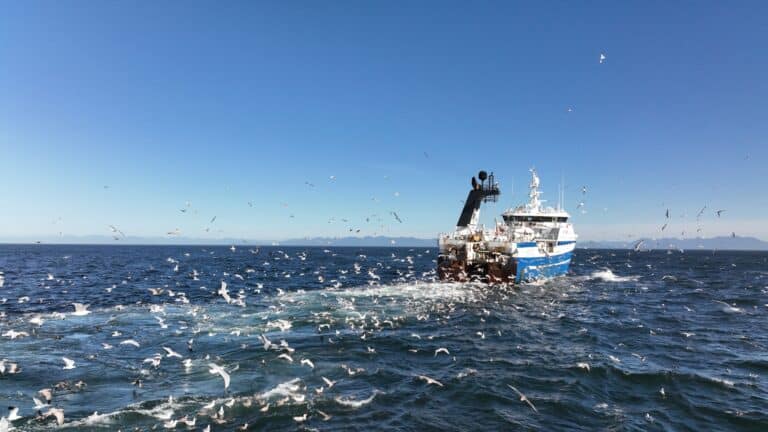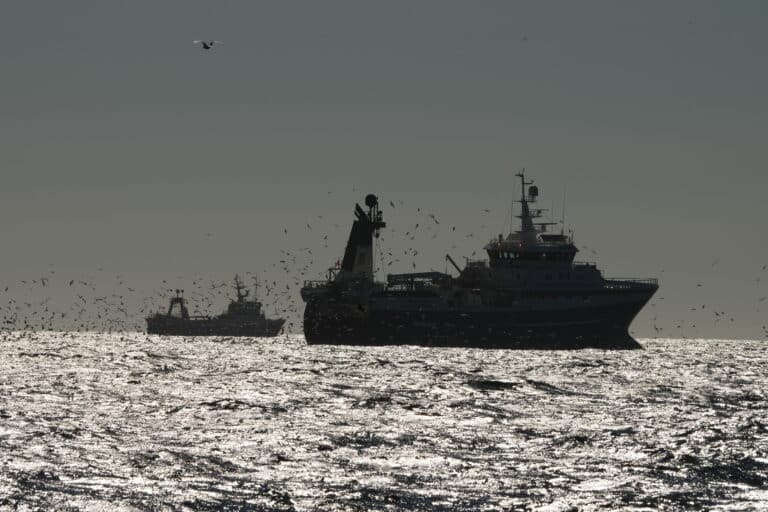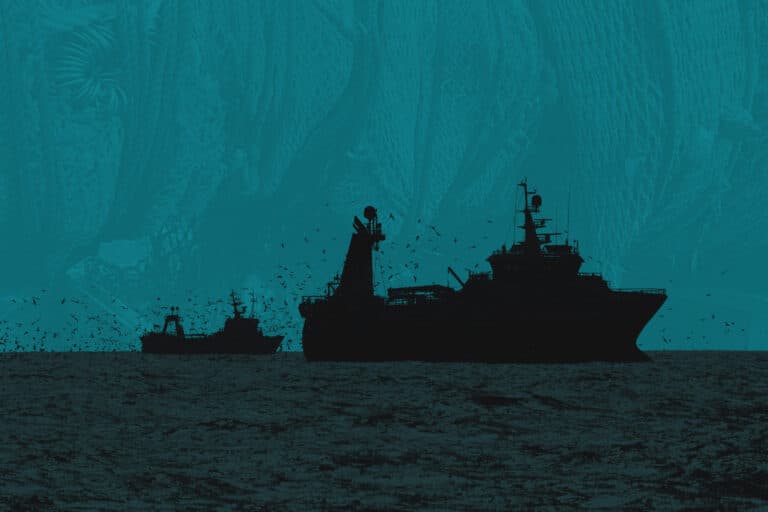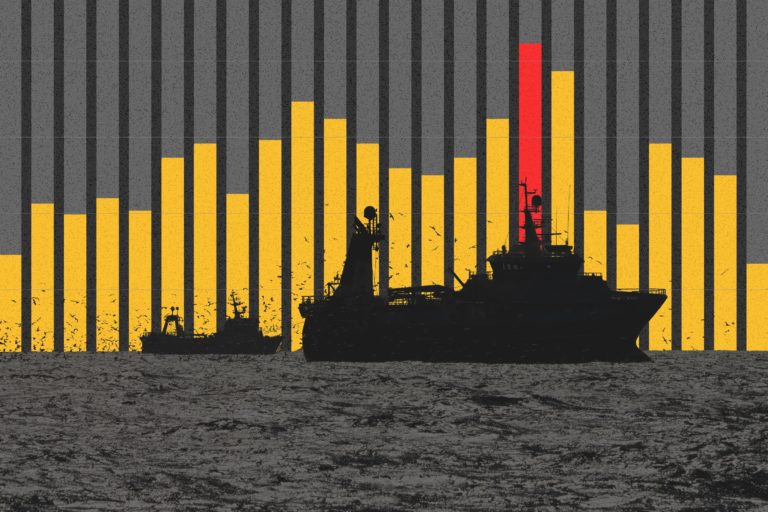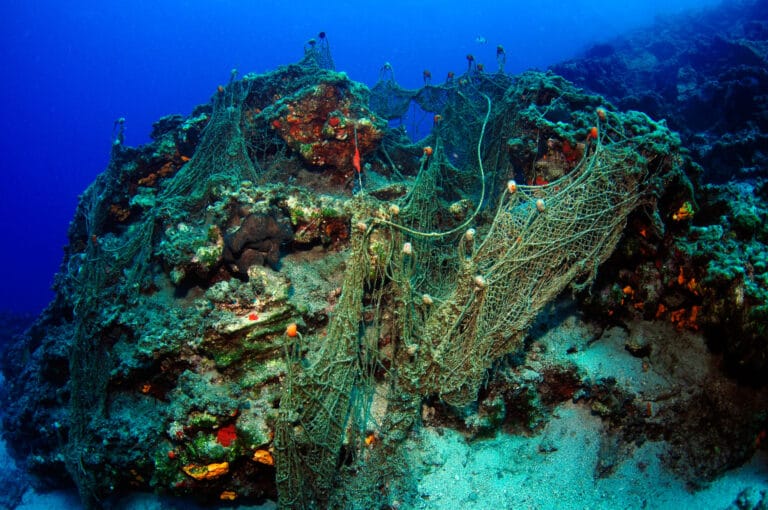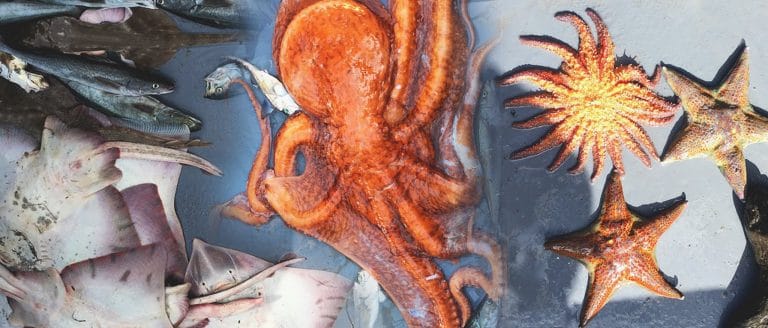Bottom trawling is a non-selective fishing practice which herds fish and captures target species using nets that tow along the ocean floor. In Canada, bottom trawls are used in the commercial groundfish fishery. Groundfish are caught using a variety of methods including bottom trawls, long line fishing and hydraulic dredges. In Canadian commercial fisheries, groundfish are most commonly caught using larger vessels with bottom trawl nets that drag along the sea floor for hours at a time. Trawl nets are the largest form of gear and can be as long as a football field and as tall as a three-story building.
There are two types of trawl nets used in Canada: beam trawls, which are long metal beams that hold open the mouth of the net; and otter trawls, which have doors that are used to keep the nets open. Fishing vessels use either midwater trawls, which catch species in the water column above the seafloor, or bottom trawl and drag along the ocean seabed. This fishing method is indiscriminate, catching any and all species in its path. This practice is the ocean counterpart of forest clear-cutting. Non-targeted species, called bycatch, will often be caught. This can include turtles, sharks, dolphins and other fish species that are often discarded overboard.
Bottom trawling in Canadian waters began in the 16th century. Initially most of the harvest was sold locally. The trawl fishery went through a number of periods of growth and decline, with a boom during both World Wars. By the mid-1980’s, Canada became the leading exporter of fish and many fish stocks began showing evidence of being overfished. To protect stocks and biodiversity, total allowable catch (TACs) limits were put in place. TAC’s quotas are used to manage and measure the amount of species caught, with a combination of license limitations and restrictions on the number of vessels allowed into the fishery. Catch limits were exceeded year after year and DFO implemented individual transferable quotas (ITQs) which would allow for vessels to share fishing quotas. The hope was that this would eliminate competition among vessels and ensure more measured catches.
There are currently 122 bottom trawl licenses issued for use in 2021. These fleets catch a variety of groundfish—the species of fish that live on or near the seafloor which are a vital part of the Pacific Northwest oceanic ecosystem. Vessels are on the water from early spring until late summer or until quota has been reached. Roughly 30,000-40,000 hours are spent trawling the water every year. An average catch will be about 38,500 tonnes with approximately 23% discarded as bycatch.
There have been 490,000 tonnes of Pacific groundfish caught in bottom trawl nets from 1996 to 2006, where 100,000 tonnes of biomass was reported to be discarded. Roughly 23% of all biomass caught was reported as bycatch, and 31% of the bycatch was considered to have no commercial value.
Not only do bottom trawls mistakenly catch non-target species, but they are also non-selective towards species that are at-risk and actively listed under the Species at Risk Act. Although there are measurements such as Marine Protected Areas (MPAs) and fishing regulations to prevent the catch and landing of these species, the non-selective nature of trawls makes it near impossible to ensure that at-risk species won’t be caught.
The Pacific North Coast waters have seen the destruction of 50% of unique glass sponge reefs. Bottom trawls have destroyed them by dragging their heavy nets and creating extreme sedimentation, blocking the feeding filters and smothering the reef’s ability to absorb oxygen. Reefs recover extremely slowly or not at all, with bottom-trawling effects lasting well over 100 years.
Boccacio Rockfish are one of the over 35 species of Rockfish found in British Columbia’s waters. The population of Boccacio have seen extreme declines in the last few years, with commercial trawl vessels still reporting small tonnages of discards. Due to the expansion of the swim bladder when Boccacio Rockfish are removed from water, many of these fish end up dead even when returned back into the ocean.
Fishing down the food web creates a change in ecosystem interactions due to overfishing, as predators are removed due to fishing activity. This also results in prey species changing their behaviours from being predator-averse to being aggressive foragers which impacts the entire trophic structure and ecosystem.
With larger predators and higher trophic levels depleted, fishing industries have moved to fishing smaller fish that are lower on the food chain as they become the new target species. The groundfish industry is contributing to this phenomenon. Groundfish are now suffering from over-exploitation and climate-induced declines in stock productivity resulting from fishing out the larger fish. Healthy groundfish populations contribute to stable and sustainable oceans that are full of life. There are nearly 90 different types of groundfish including species of rockfish, sablefish, pacific cod and lingcod, flatfish, skates, and sharks.
Bottom trawls are the most damaging fishing gear type to populations, communities and seafloor habitats. They cause destruction of non-target benthos such as slow-growing species like corals and sponges. Bottom trawls remove and kill species, leaving a lasting effect on the food web, which takes decades to regenerate.
Due to the repetitive removal of specific species and generally larger bodied sea life, the resultant community in a heavily trawled area is one dominated by species that are well adapted to regular physical disturbance and often quite different from those in an undisturbed area. There is also a measurable reduction in ocean productivity as ecosystems ability to produce biomass and living matter is affected by the damages of trawling. Benthic habitats are used as shelter and food sources for several juvenile fish. If bottom trawling impacts the habitat and survivorship, there is potential for irreversible ecosystem impacts.
MPAs are geographically defined sections of the ocean that are under special management and are protected for restoration of endangered species and ecosystems. Protection and management methods are quite varied across MPAs. There are also limits in place for non-target species that are caught in trawls. Once the limits are met, fishing boats must either end their fishing season or secure more bycatch quota from other vessels.
The transparency and regulation of bottom-trawling is insufficient. Throughout the month of August, we will be launching our #InDeepTrouble campaign, opening up the conversation surrounding the destructive groundfish bottom trawling in Canada. Keep an eye out for more information and ways you can get involved to encourage a re-working of our fisheries management and to #BanBottomTrawling.
Bottom trawling—the ocean equivalent to old-growth clearcutting—is destroying our oceans. Groundfish, such as Yellowtail Rockfish are paying the biggest price.
Learn more about bottom trawling through our video narrated by Sarah Wayne Callies!
Sources
- Fisheries and Oceans Canada
- Sea Around Us
- David Suzuki Foundation
